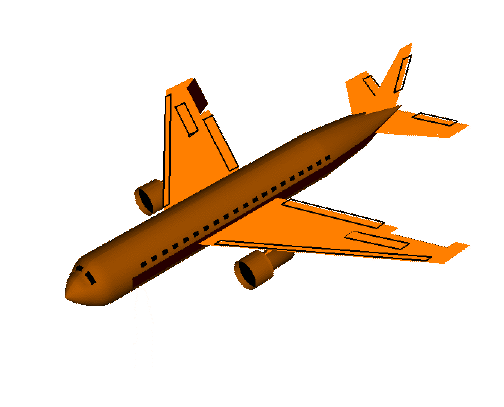 |
|
Glenn
|

 |
|
Glenn
|

This slide shows what happens when a pilot deflects the ailerons, which are small hinged sections on the outboard portion of the wing. Ailerons usually work in opposition: as the right aileron is deflected upward, the left is deflected downward, and vice versa.
As described on the shape effects slide, changing the angle of deflection at the rear of an airfoil will change the amount of lift generated by the foil. With greater downward deflection, the lift will increase in the upward direction. Notice on this slide that the aileron on the right wing, as viewed from the front of the aircraft, is deflected down. The aileron on the left wing is deflected up. Therefore, the lift on the right wing is increased, while the lift on the left wing is decreased. Because the forces are not equal, there is a net twist about the center of gravity in the direction of the larger force. The resulting motion will roll the aircraft to the left (counterclockwise) as viewed from the front. If the pilot reverses the aileron deflections (left aileron down, right aileron up) the aircraft will roll in the opposite direction.
[You can test this effect yourself using a paper airplane. Just cut some control tabs into the rear of both wings. Bend one tab up and the other down, and you will see the airplane roll when it is flown. The roll will be in the direction of the tab that is pulled up. The same thing will work on a simple wooden glider. The tabs can be yellow stick-ums or tape attached to the wings.]
When you travel on an airliner, watch the wings during turns. The pilot rolls the aircraft in the direction of the turn. You will probably be surprised at how little deflection is necessary to bank (roll) a large airliner. But be warned that there is a possible source of confusion on some airliners. We have been talking here about rolling the aircraft by using a pair of ailerons at the very trailing edge of both wings to increase or decrease the lift of each wing. On some airliners, the aircraft is rolled by killing the lift on only one wing at a time. A plate, called a spoiler, is raised between the leading and trailing edges of the wing. This effectively changes the shape of the airfoil, disrupts the flow over the wing, and causes a section of the wing to decrease its lift. This produces an unbalanced force with the other wing, which causes the roll. Airliners use spoilers because spoilers can react more quickly than ailerons and require less force to activate, but they always decrease the total amount of lift for the aircraft. It's an interesting trade! You can tell whether an airliner is using spoilers or ailerons by noticing where the moving part is located. At the trailing edge, it's an aileron; between the leading and trailing edges, it's a spoiler. (Now you can dazzle the person sitting next to you on the plane!)
Last Updated Thu, May 13 02:38:18 PM EDT 2021
by Ruth Petersen, 9/9/99